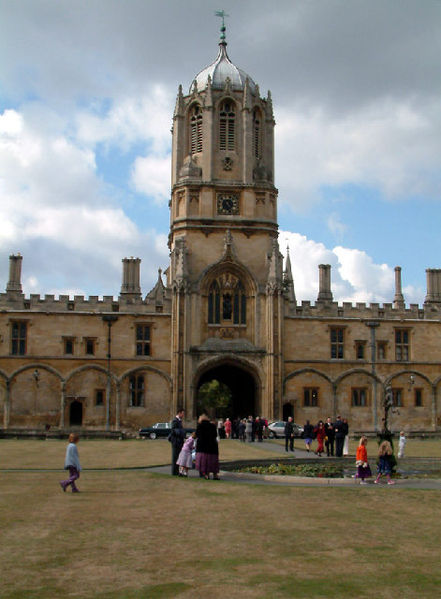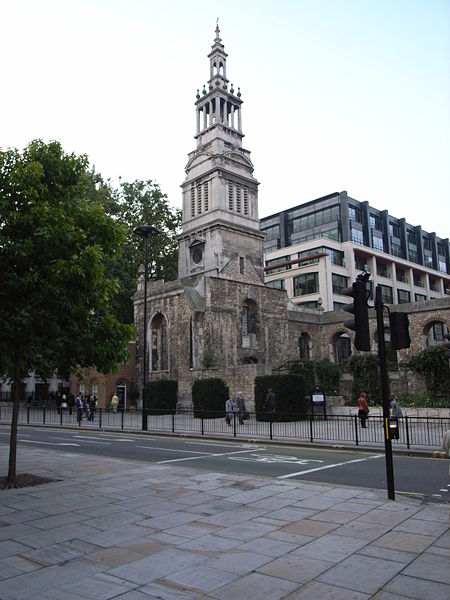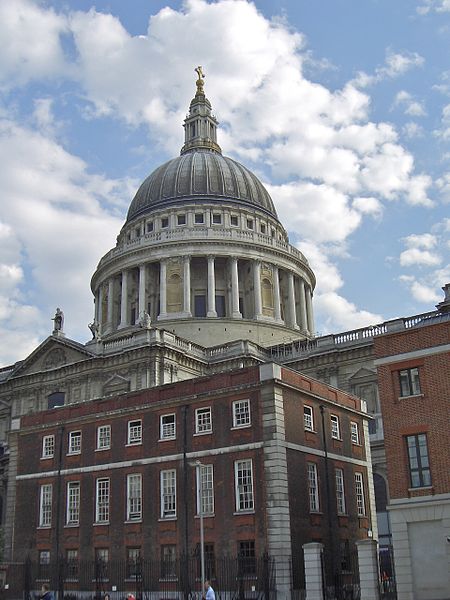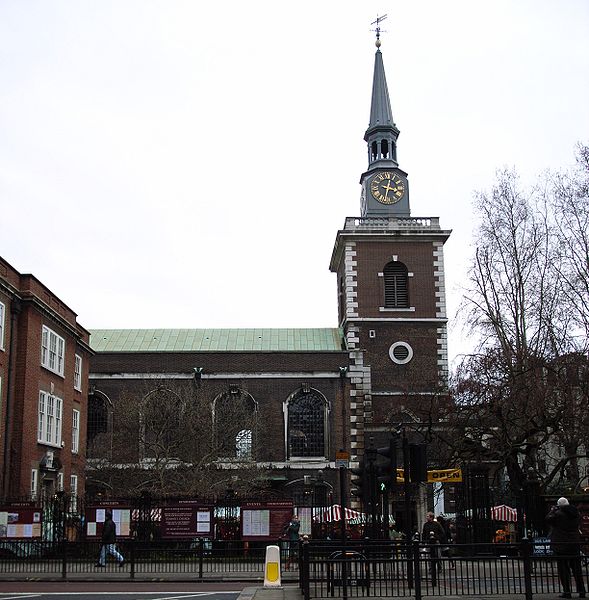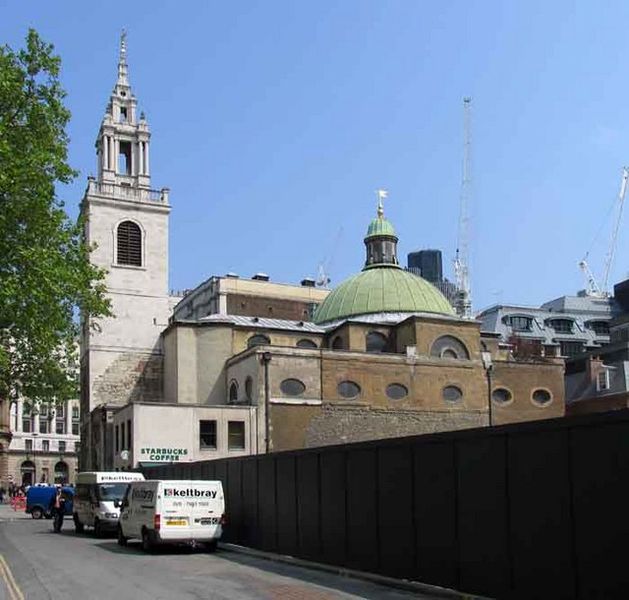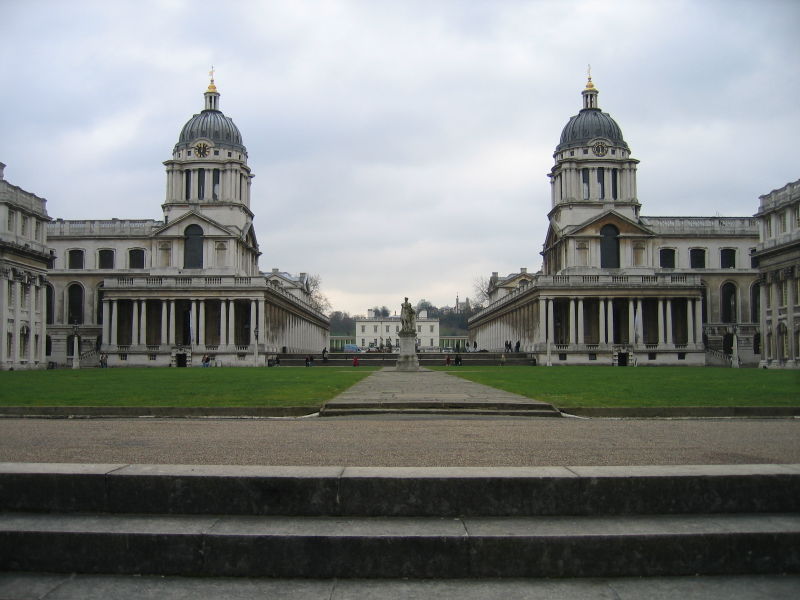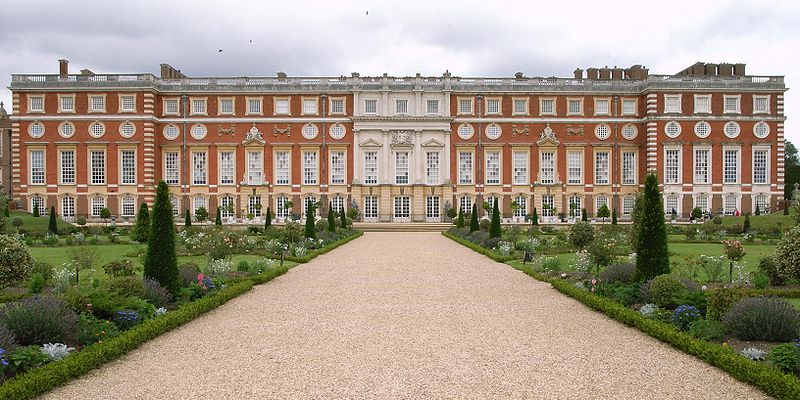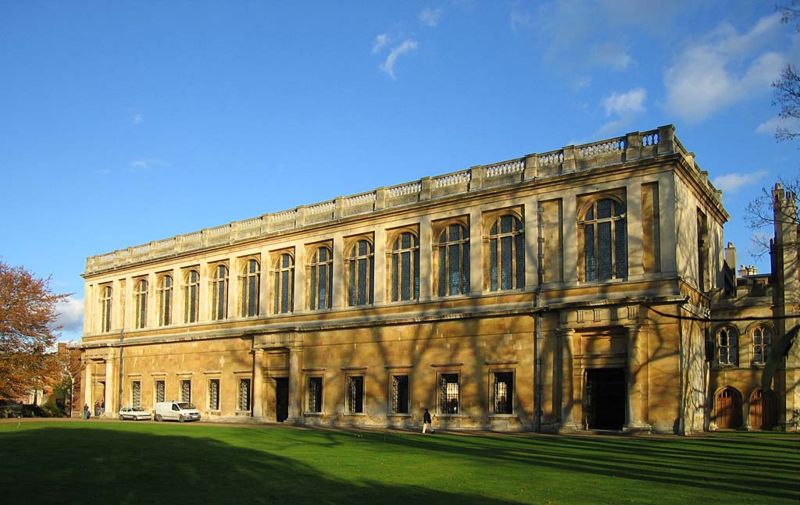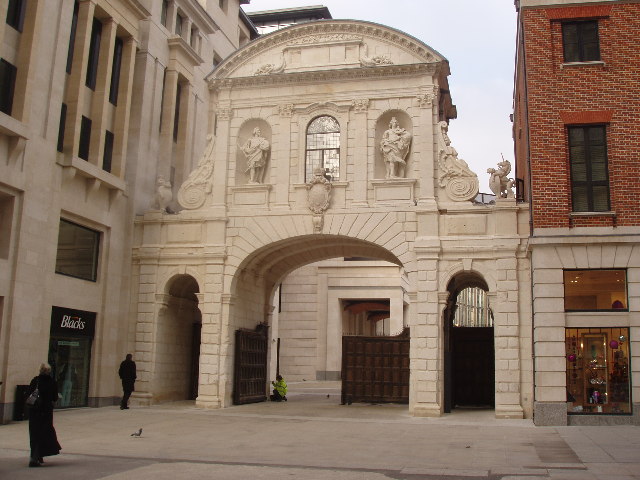<Back to Index>
- Physicist James Chadwick, 1891
- Architect Christopher Wren, 1632
- 1st President of Kenya Jomo Kenyatta, 1894
PAGE SPONSOR

Sir Christopher Wren (20 October 1632 – 25 February 1723) was one of the most highly acclaimed English architects in history, responsible for rebuilding 51 churches in the City of London after the Great Fire in 1666, including his masterpiece, St. Paul's Cathedral, completed in 1710.
Educated in Latin and Aristotelian physics at the University of Oxford, Wren was a notable astronomer, geometer, mathematician - physicist as well as an architect. He was a founder of the Royal Society (president 1680 – 82), and his scientific work was highly regarded by Sir Isaac Newton and Blaise Pascal. Wren was born at East Knoyle in Wiltshire, the only surviving son of Christopher Wren DD (1589 – 1658), at that time the rector of East Knoyle and later Dean of Windsor. A previous child of Dr Wren, also named Christopher, was born on 22 November 1631, and had died the same day. John Aubrey’s confusion of the two persisted occasionally into late twentieth century literature. As a child Wren "seem'd consumptive". Although
a sickly child, he would survive into robust old age. He was first
taught at home by a private tutor and his father. After his father's
appointment as Dean of Windsor in
March 1635, his family spent part of each year there. Little is known
about Wren’s life at Windsor. Little also is known of Wren’s schooling.
The story that he was at Westminster School from 1641 to 1646 is unsubstantiated. Parentalia,
the biography compiled by his son, a third Christopher, places him
there "for some short time" before going to Oxford (in 1650). Some of
his youthful exercises preserved or recorded (though few are datable)
showed that he received a thorough grounding in Latin; he also learned to draw. According to Parentalia, he was "initiated" in the principles of mathematics by Dr William Holder, who married Wren’s elder sister Susan (or Susanna) in 1643. During this
time period, Wren manifested an interest in the design and construction
of mechanical instruments. It was probably through Holder that Wren met Sir Charles Scarburgh whom Wren assisted in his anatomical studies. On 25 June 1650, Wren entered Wadham College, Oxford where he studied Latin and the works of Aristotle.
It is anachronistic to imagine that he received scientific training in
the modern sense. However, Wren became closely associated with John Wilkins,
who served as warden in Wadham. Wilkins was a member of a group of
distinguished scholars. This group, whose activities led to the
formation of the Royal Society,
consisted of a number of distinguished mathematicians, original and
sometimes brilliant practical workers and experimental philosophers.
This connection probably influenced Wren’s studies of science and
mathematics at college. He graduated B.A. in 1651, and three years
later received M.A. Receiving his M.A. in 1653, Wren was elected a fellow of All Souls College in
the same year and began an active period of research and experiment in
Oxford. His days as a fellow of All Souls ended when Wren was appointed
Professor of Astronomy at Gresham College, London, in 1657. He was provided with a set of rooms and a stipend and was required to give weekly lectures in both Latin and
English to all who wished to attend; admission was free. Wren took up
this new work with enthusiasm. He continued to meet the men with whom
he had frequent discussions in Oxford. They attended his London lectures and in 1660, initiated formal weekly meetings. It was from these meetings that the Royal Society,
England’s premier scientific body, was to develop. He undoubtedly
played a major role in the early life of what would become the Royal
Society; his great breadth of expertise in so many different subjects
helping in the exchange of ideas between the various scientists. In
fact, the report on one of these meetings reads: In
1662, they proposed a society "for the promotion of
Physico-Mathematicall Experimental Learning." This body received its
Royal Charter from Charles II and "The Royal Society of
London for the Promotion of Natural Knowledge" was formed. In addition
to being a founder member of the Society, Wren was president of the
Royal Society from 1680 to 1682. In 1661, Wren was elected Savilian Professor of Astronomy at
Oxford, and in 1669 he was appointed Surveyor of Works to Charles II.
From 1661 until 1668 Wren's life was based in Oxford, although the
Royal Society meant that he had to make occasional trips to London. The main sources for Wren's scientific achievements are the records of the Royal Society. His scientific works ranged from astronomy, optics, the problem of finding longitude at sea, cosmology, mechanics, microscopy, surveying, medicine and meteorology.
He observed, measured, dissected, built models, and employed, invented
and improved a variety of instruments. It was also around these times
that his attention turned to architecture. It was probably around this time that Wren was drawn into redesigning a battered St Paul's Cathedral.
Making a trip to Paris in 1665, Wren studied the architecture, which
had reached a climax of creativity, and perused the drawings of Bernini,
the great Italian sculptor and architect. Returning from Paris, he made
his first design for St Paul’s. A week later, however, the Great Fire destroyed
two-thirds of the city. Wren submitted his plans for rebuilding the
city to King Charles II, although they were never adopted. With his
appointment as King’s Surveyor of Works in 1669, he had a presence in
the general process of rebuilding the city, but was not directly
involved with the rebuilding of houses or companies' halls. Wren was
personally responsible for the rebuilding of 51 churches; however, it is not necessarily true to say that each of them represented his own fully developed design. Wren was knighted 14
November 1673. This honour was bestowed on him after his resignation
from the Savilian position in Oxford, by which time he had already
begun to make his mark as an architect, both in services to the Crown and in playing an important part in rebuilding London after the Great Fire. Additionally, he was sufficiently active in public affairs to be returned as Member of Parliament for Old Windsor in 1680, 1689 and 1690, but did not take his seat. By 1669 Wren's career was well established and it may have been his appointment as Surveyor of the King's Works in
early 1669 that persuaded him that he could finally afford to take a
wife. In 1669 the thirty-seven year old Wren married his childhood
neighbour, the thirty-three year old Faith Coghill, daughter of Sir
John Coghill of Bletchingham. Little is known of Faith's life or demeanour, but a love letter from Wren survives, which reads, in part: This
brief marriage produced two children: Gilbert, a sickly child given to
convulsions, born October 1672; the infant died not quite a
year and a half old. The second child, also a son, named Christopher
after his father, was born February 1675. The younger Christopher was
trained by his father to be an architect. It was this Christopher that
supervised the topping out ceremony of St Paul's in 1710 and wrote the famous Parentalia, or, Memoirs of the family of the Wrens. Faith Wren died of smallpox on 3 September 1675. She was buried in the chancel of St Martin-in-the-Fields beside
the infant Gilbert. A few days later Wren's mother-in-law, Lady
Coghill, arrived to take the infant Christopher back with her to
Oxfordshire to raise. In
1677, seventeen months after the death of his first wife, Wren married
once again. He married Jane Fitzwilliam, a woman even more of a mystery
than the first Mrs Wren; especially to Wren's friends and companions. Robert Hooke,
who often saw Wren two or three times every week, had, as he recorded
in his diary, never even heard of her, and was not to meet her till six
weeks after the marriage. All that is known about the second Mrs Wren was that she was the daughter of Lord Fitzwilliam of Lifford on
the Irish peerage, and that her mother had been the daughter of a
prosperous London merchant. As with the first marriage, this too
produced two children: a daughter Jane (1677 – 1702); and a son
William,
"Poor Billy" born June, 1679, who was developmentally delayed. Like the
first, this second marriage was also brief. Jane Wren died of tuberculosis in
September 1680. She was buried alongside Faith and Gilbert in the
chancel of St Martin-in-the-Fields. Wren was never to marry again; he
lived to be over 90 years old and of those was married only nine. Bletchingham
was the home of Wren's brother-in-law William Holder who was rector of
the local church. Holder had been a Fellow of Pembroke College, Oxford. An intellectual of considerable ability, he is said to have been the figure who introduced Wren to arithmetic and geometry. Wren's later life was not without criticisms and attacks on his competence and his taste. In 1712, the Letter Concerning Design of Anthony Ashley Cooper, third Earl of Shaftesbury,
circulated in manuscript. Proposing a new British style of
architecture, Shaftesbury censured Wren’s cathedral, his taste and his
long standing control of royal works. Although Wren was appointed to
the Fifty New Churches Commission in 1711, he was left only with
nominal charge of a board of works when the surveyorship started in
1715. On 26 April 1718, on the pretext of failing powers, he was
dismissed in favour of William Benson. Contrary to popular belief, Wren did not die at his son’s house. The Wren family estate was in the area of Hampton Court.
It had been bought by Wren many years before as part of a legacy for
his son Christopher Wren, Jr. For convenience Wren also leased a house
on St James's Street in
London. According to a nineteenth century legend, he would often go to
London to pay unofficial visits to St Paul's, to check on the progress
of "my greatest work". On one of these trips to London he caught a
chill. Over the next several days the illness became increasingly
worse. On 25 February 1723 a servant tried to awaken Wren from his nap,
but found that Wren had died. Wren
was laid to rest on 5 March 1723. His remains were placed in the
south-east corner of the crypt of St Paul's beside those of his
daughter Jane, his sister Susan Holder, and her husband William. The plain stone plaque was written by Wren's eldest son and heir, Christopher Wren, Jr. The inscription ends: "LECTOR, SI MONUMENTUM REQUIRIS, CIRCUMSPICE." which translates from Latin as: "Reader, if you seek his memorial – look around you."
One of Wren's friends, another great scientist and architect in his time, Robert Hooke said of him "Since the time of Archimedes there scarce ever met in one man in so great perfection such a mechanical hand and so philosophical mind." When a fellow of All Souls, Wren constructed a transparent beehive for scientific observation; he began observing the moon, which was to lead to the invention of micrometers for the telescope. He experimented on terrestrial magnetism and had taken part in medical experiments while at Wadham College, performing the first successful injection of a substance into the bloodstream (of a dog). In Gresham College, he did experiments involving determining longitude through magnetic variation and through lunar observation to help with navigation, and helped construct a 35-foot (11 m) telescope with Sir Paul Neile. Wren also studied and improved the microscope and telescope at this time. He had also been making observations of the planet Saturn from around 1652 with the aim of explaining its appearance. His hypothesis was written up in De corpore saturni but before the work was published, Huygens presented his theory of the rings of Saturn. Immediately Wren recognized this as a better hypothesis than his own and De corpore saturni was
never published. In addition, he constructed an exquisitely detailed
lunar model and presented it to the king. Also his contribution to mathematics should be noted; in 1658, he found the length of an arc of the cycloid using
an exhaustion proof based on dissections to reduce the problem to
summing segments of chords of a circle which are in geometric
progression. A year into Wren's appointment as a Savilian Professor in Oxford, the Royal Society was created and Wren became an active member. As a Savilian Professor, Wren studied thoroughly in mechanics, especially in elastic collisions and pendulum motions, which he studied extensively. He also directed his far ranging intelligence to the study of meteorology,
and fabricated a "weather-clock" that recorded temperature, humidity,
rainfall and barometric pressure, which could be used to predict the
weather. In addition, Wren experimented on muscle functionality as
well, hypothesizing that the swelling and shrinking of muscles might
proceed from a fermentative motion arising from the mixture of two
heterogeneous fluids. Although this is incorrect, it is at least
founded upon observation and may mark a new outlook on medicine:
specialization. Another topic to which Wren contributed was optics.
He published a description of an engine to create perspective drawings
and he discussed the grinding of conical lenses and mirrors. Out of
this work came another of Wren's important mathematical results, namely
that the hyperboloid of
revolution is a ruled surface. These results were published in 1669. In
subsequent years, Wren continued with his work with the Royal Society,
although after the 1680s his scientific interests seem to have waned:
no doubt his architectural and official duties absorbed all his time. It was a problem posed by Wren that serves as an ultimate source to the conception of Newton's Principia Mathematica Philosophiae Naturalis. Robert Hooke had theorized that planets, moving in vacuo,
describe orbits around the Sun because of a rectilinear inertial motion
by the tangent and an accelerated motion towards the Sun. Wren's
challenge to Halley and
Hooke, was, for the reward of 30 shilling worth book, to provide,
within the context of Hooke’s hypothesis, a mathematical theory linking
the Kepler's laws with a specific force law. Halley took the problem to Newton for advice, prompting the latter to write a 9-page answer, De Motu, which was later to be expanded into the Principia. Mentioned above are only a few of Wren’s scientific works. He also studied in other areas not mentioned, ranging from agriculture, ballistics, water and freezing, to investigating light and refraction only to name a few. Thomas Birch's History of the Royal Society is
one of the most important sources of our knowledge not only of the
origins of the Society, but also the day to day running of the Society.
It is in these records that the majority of Wren’s scientific works are
recorded. In
Wren's age, the profession of architect as understood today did not
exist. Since the early years of the 17th century it was not unusual for the well educated gentleman, (virtuosi), to take up architecture
as a gentlemanly activity; a pursuit widely accepted as a branch of
applied mathematics. This is implicit in the writings of Vitruvius and explicit in such sixteenth century authors as John Dee and Leonard Digges. When Wren was a student at Oxford, he became familiar with Vitruvius's De architectura and absorbed intuitively the fundamentals of the architectural design there. In the past,
buildings had been constructed to the needs of the patron and the
suggestions of building professionals, such as master carpenters or
master bricklayers. Through
the Royal Society and his use of optics, The King noticed Wren's works.
In 1661 he was approached by his cousin Matthew with a royal
commission, as "one of the best Geometer in Europe", to direct the
re-fortification of Tangier.
Wren excused himself on grounds of health. Although this invitation may
have arisen from Charles II's casual opportunism in matching people to
tasks, Wren is believed to have been already on the way to architecture
practice. Before the end of 1661 Wren was unofficially advising the
repair of Old St Paul's Cathedral after
two decades of neglect and distress; his architectural interests were
also evident to his associates at the time. Two years after, he set his
only foreign journey to Paris and the Île-de-France,
during which he acquired the firsthand study of modern design and
construction. By this time, he had mastered and thoroughly understood
architecture. Unlike several of his colleagues who took it up as a set
of rules and formulas for design, he possessed, understood, and
exploited the combination of reason and intuition, experience and
imagination. Wren's first architectural project was the chapel of Pembroke College in Cambridge, which his uncle, the Bishop of Ely, asked him to design in 1663. The second was the design of the Sheldonian Theatre in Oxford, completed in 1668. This, the gift of Archbishop Sheldon to his old university, was influenced by the classical form of the Theatre of Marcellus in Rome, but was a mixture of this classical design with a modern empirical design. St Paul's has
always been the touchstone of Wren's reputation. His association with
it spans his whole architectural career, including the thirty-six years
between the start of the new building and the declaration by parliament
of its completion in 1711. Wren
had been involved in repairs of the old cathedral since 1661. In the
spring of 1666, he made his first design for a dome for St Paul's. It was accepted in principle on August 27, 1666. One week later, however, the Great Fire of London reduced
two-thirds of the City to a smoking desert and old St Paul's to a ruin.
Wren was most likely at Oxford at the time, but the news, so
fantastically relevant to his future, drew him at once to London.
Between 5 and 11 September he ascertained the precise area of
devastation, worked out a plan for rebuilding the City and submitted it
to Charles II. Others also submitted plans. However, no new plans
proceeded any further than the paper on which it was drawn. A
rebuilding act which provided rebuilding of some essential buildings
was passed in 1667. In 1669, the King's Surveyor of Works died and Wren
was promptly installed.
It was not until 1670 that the pace of rebuilding started accelerating.
A second rebuilding act was passed that year, raising the tax on coal
and thus providing a source of funds for rebuilding of churches
destroyed within the City of London.
Wren presented his initial "First Model" for St Paul's. This plan was
accepted, and demolition of the old cathedral began. By 1672, however,
this design seemed too modest, and Wren met his critics by producing a
design of spectacular grandeur. This modified design, called "Great
Model", was accepted by the King and the construction started in
November, 1673. However, this design failed to satisfy the chapter and
clerical opinion generally; moreover, it had an economic drawback. Wren
was confined to a "cathedral form" desired by the clergy. In 1674 he
produced the rather meagre Classical - Gothic compromise known as the
Warrant Design. However, this design, called so from the royal warrant
of 14 May 1675 attached to the drawings, is not the design upon which work had begun a few weeks before. The
cathedral that Wren started to build bears only a slight resemblance to
the Warrant Design. In 1697, the first service was held in the
cathedral when Wren was 65. There was still, however, no dome. Finally
in 1711 the cathedral was declared complete, and Wren was paid the half
of his salary that, in the hope of accelerating progress, Parliament had
withheld for fourteen years since 1697. The cathedral had been built
for 36 years under his direction, and the only disappointment he had
about his masterpiece was the dome: against his wishes the commission
engaged Thornhill to paint the inner dome in false perspective and
finally authorized a balustrade around
the proof line. This diluted the hard edge Wren had intended for his
cathedral, and elicited the apt parthian comment that "ladies think
nothing well without an edging". During
the 1670s Wren received significant secular commissions which manifest
both the maturity and the variety of his architecture and the sensitivity of his response to diverse briefs. Among many of his
remarkable designs at this time, the monument commemorating the Great Fire, the Royal Observatory, and the library at Trinity College, Cambridge, were the most important ones. The former two of the three works also involved Robert Hooke, but Wren was in control of the final design. By
historical accident, all Wren's large scale secular commissions dated
from after the 1680s. At the age of fifty his personal development, as
was that of English architecture, was ready for a monumental but humane
architecture, in which the scales of individual parts relates both to
the whole and to the people who used them. The first large project Wren
designed, the Chelsea Hospital,
does not entirely satisfy the eye in this respect, but met its belief
with such distinction and success that even in the twenty first century
it fulfills its original function. The reconstruction of the state room
at Windsor Castle was notable for the integration of architecture, sculpture, and painting. This commission was in the hand of Hugh May, who died in February, 1684, before the construction finished; Wren assumed his post and finalized the works. After the death of Charles II in 1685, Wren's attention was directed mainly to Whitehall. The new king, James II, required a new chapel and also ordered a new gallery, council chamber and a riverside apartment for the Queen. Later, when James II was removed from the throne, Wren took on architectural projects such as Kensington Palace and Hampton Court. Wren
did not pursue his work on architectural design as actively as he had
before the 1690s, although he still played important roles in a number
of royal commissions. In 1696 he was appointed Surveyor of Greenwich Naval Hospital, and three years later Surveyor of Westminster Abbey. He resigned the former role in 1716 but held the latter until his death. At
his death, Wren was 90. Even the men he had trained and who owed much
of their success to Wren's original and leadership were no longer
young. Newer generations of architects were beginning to look past
Wren's style. The Baroque school
his apprentices had created was already under fire from a new
generation that brushed Wren’s reputation aside and looked back beyond
him to Inigo Jones.
Architects of the 18th century could not forget Wren, but they could
not forgive some elements in his work they deemed unconventional. The
churches left the strongest mark on subsequent architecture. In France,
where English architecture rarely made much impression, the influence
of St Paul's Cathedral can be seen in the church of
Sainte-Geneviève (now the Panthéon); begun in 1757, it rises to a drum and dome similar to St Paul's, and there are other versions inspired by Wren's dome, from St Isaac's (1840 – 42) in St Petersburg to the US Capitol at Washington, D.C. (1855 – 65). In
the twentieth century the potency of the influence of Wren's work on
English architecture was reduced. The last major architect who admitted to being dependent on him was Sir Edwin Lutyens, who died in 1944. With the purposeful elimination of historic influences from international architecture in the early 20th century, Wren's work gradually stopped being perceived as a mine of examples applicable to contemporary design. Sir Christopher Wren may also have been a Freemason and
Master of Lodge Original, No. 1, now the Lodge of Antiquity No. 2. He
is said to have been "adopted" May 18, 1691. This is debated. From march 20th 1981 until 1994, Wren's picture appeared on the reverse of Series D £50 banknotes issued by the Bank of England.
He was shown against a backdrop of the skyline of London as it would
have appeared in 1711 with St Paul's towering above the other city
buildings. With his left hand, Wren points to an architectural plan of the cathedral. The design of the note incorporates neoclassical details from Wren's work. The crater Wren on Mercury was named in his honour. The house of Wren's at Westminster School in England was named after him. The main hall at the College of William and Mary in Williamsburg, Virginia, in the United States of America is named The Wren Building in his honor.
